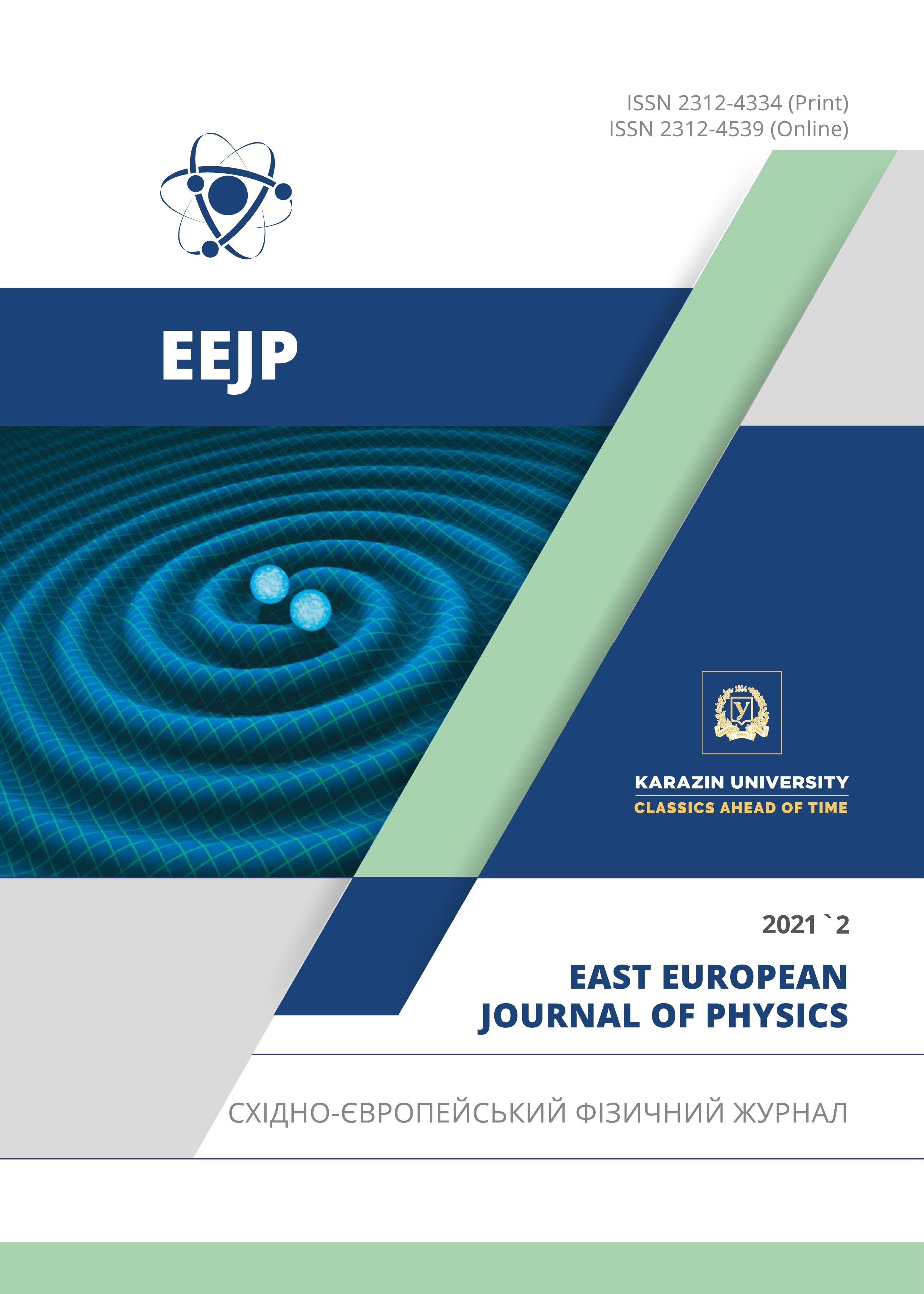Мікроструктура та зміцнення сталей х18н10т і х18н10т-дзо, опромінених іонами аргону
Анотація
Вивчено зміну мікроструктури і нанотвердості в сталях Х18Н10Т та Х18Н10Т-ДЗО після опромінення іонами аргону за допомогою комбінації методів наноіндентування, рентгеноструктурного аналізу, просвічуючої та скануючої електронної мікроскопії. Модифікований ДЗО сплав був отриманий на основі звичайної аустенітної сталі Х18Н10Т шляхом механічного легування сталевого порошку нанооксидами Y(Zr) з подальшою термо-механічною обробкою. Рентгеноструктурний аналіз не показав суттєвих змін в структурі сталі Х18Н10Т після опромінення при кімнатній і підвищених температурах (873 K) і в ДЗО-сталі після опромінення при 873 K, тоді як ознаки подрібнення доменів і появи мікродеформації були виявлені після опромінення сталі Х18Н10Т-ДЗО при кімнатній температурі (КT). Пошаровий ПЕМ-аналіз проводився для дослідження мікроструктури сплавів вздовж профіля пошкоджень. Більш висока концентрація пошкоджень і Ar явно призводить до збільшення розміру порожнин і їх щільності в обох сталях. Розпухання склало майже половину для Х18Н10Т-ДЗО (4,8%) у порівнянні з Х18Н10Т (9,4%), що свідчить про поліпшений опір розпуханню в ОДЗ-сталі. Обговорюється роль границі розподілу оксид/матриця як стоку для радіаційних точкових дефектів і атомів інертного газу. Дрібнодисперсні частки оксиду розглядаються як ефективний фактор в пригніченні укрупнення порожнин і обмеження скупчень дефектів невеликим розміром. Поведінку твердості досліджували як на неопромінених, так і на опромінених зразках і порівнювали з такими при кімнатній температурі і підвищеній температурі опромінення. Підвищення твердості неопроміненої ДЗО-сталі в основному пов'язано з подрібненням зерна і додаванням частинок оксиду ітрію. Зміцнення сталі Х18Н10Т-ДЗО після опромінення іонами Ar при кімнатній температурі виявилося набагато нижче, ніж Х18Н10Т. Для обох сталей в приповерхневій області спостерігаються чорні точки і дислокаційні петлі; однак основний ефект зміцнення обумовлений порожнинами. Було встановлено, що ДЗО-сталь менш схильна до радіаційного зміцнення/окрихчення в порівнянні зі звичайною аустенітною сталлю.
Завантаження
Посилання
V.N. Voyevodin, and I.M. Neklyudov, Evolution of the Structural-Phase State and Radiation Resistance of Structural Materials, (Kiev, Naukova Dumka, 2006). (in Russian)
S.J. Zinkle, and J.T. Busby, Mat. Today, 12, 12-19 (2009), https://doi.org/10.1016/S1369-7021(09)70294-9.
G.S. Was, and R.S. Averback, Comprehensive Nuclear Materials, 1, 195-221 (2012). https://doi.org/10.1016/B978-0-08-056033-5.00007-0.
А.N. Velikodnyi, V.N. Voyevodin, M.A. Tiкhonovsky, V.V. Bryk, A.S. Kalchenko, S.V. Starostenko, I.V. Kolodiy, V.S. Okovit, А.М. Bovda, L.V. Onischenko, and G.Ye. Storogilov, PAST, 4(92), 94-102 (2014), https://vant.kipt.kharkov.ua/ARTICLE/VANT_2014_4/article_2014_4_94.pdf. (in Russian)
G.D. Tolstolutskaya, V.V. Ruzhytskiy, I.E. Kopanetz, V.N. Voyevodin, A.V. Nikitin, S.A. Karpov, A.A. Makienko, and T.M. Slusarenko, PAST, 1, 135-140 (2010), https://vant.kipt.kharkov.ua/ARTICLE/VANT_2010_1/article_2010_1_135.pdf. (in Russian).
R.E. Stoller, M.B. Toloczko, G.S. Was, A.G. Certain, S. Dwaraknath, and F.A. Garner, Nucl. Instrum. Methods Phys. Res. Sect. B: Beam Interact. Mater. Atoms, 310, 75 80 (2013), http://dx.doi.org/10.1016/j.nimb.2013.05.008.
ASTM E521-96, 2009, ASTM, https://doi.org/10.1520/E0521-96R09E01.
G.N. Tolmachova, G.D. Tolstolutskaya, S.A. Karpov, B.S. Sungurov, and R.L. Vasilenko, PAST, 5(99), 168–173 (2015), https://vant.kipt.kharkov.ua/ARTICLE/VANT_2015_5/article_2015_5_168.pdf.
W.C. Oliver, and G.M. Pharr, J. Mater. Res. 7(6), 1564-1583 (1992), https://doi.org/10.1557/JMR.1992.1564.
M.B. Toloczko, F.A. Garner, V.N. Voyevodin, V.V. Bryk, O.V. Borodin, V.V. Mel’nychenko, and A.S.Kalchenko, Journal of Nuclear Materials, 453, 323-333 (2014), https://doi.org/10.1016/j.jnucmat.2014.06.011.
M. Klinger, Journal of Applied Crystallography, 50, 1226-1234 (2017), https://doi.org/10.1107/S1600576717006793.
N.N. Kumar, R. Tewari, P. Mukherjee, N. Gayathri, P.V. Durgaprasad, G.S. Taki, J.B.M. Krishna, A.K. Sinha, P. Pant, A.K. Revally, B.K. Dutta, and G.K. Dey, Radiation Effects and Defects in Solids, 1370520, 678-694 (2017), http://dx.doi.org/10.1080/10420150.2017.1379520.
P. Mukherjee, A. Sarkar, M. Bhattacharya, N. Gayathri, and P. Barat, Journal of Nuclear Materials, 395, 37-44 (2019), https://doi.org/10.1016/j.jnucmat.2009.09.013.
E. Aydogan, O. El-Atwani, M. Li, and S.A. Maloy. Materials Characterization., 170, 110686 (2020). https://doi.org/10.1016/j.matchar.2020.110686.
S. Ahmad, S. Bashir, D. Yousaf, and M.A. Ali, Materials Sciences and Applications, 9, 330-344 (2018), https://doi.org/10.4236/msa.2018.93022.
Y. Osetsky, and Roger E. Stoller, Journal of Nuclear Materials, 465, 448-454 (2015), https://doi.org/10.1016/j.jnucmat.2015.05.034.
W.D. Nix, H.J. Gao, J. Mech. Phys. Solid, 46, 411–425 (1998), https://doi.org/10.1016/S0022-5096(97)00086-0.
S.A. Karpov, G.D. Tolstolutskaya, B.S. Sungurov et al., Materials Science. 52, issue 3, 377–384 (2016), https://doi.org/10.1007/s11003-016-9967-4.
V.N. Voyevodin, S.A. Karpov, G.D. Tolstolutskaya, M.A. Tikhonovsky, A.N. Velikodnyi, I.E. Kopanets, G.N. Tolmachova, A.S. Kalchenko, R.L. Vasilenko, and I.V. Kolodiy, Philosophical Magazine, 100(7), 822-836 (2020), https://doi.org/10.1080/14786435.2019.1704091.
D.C. Foley, K.T. Hartwig, S.A. Maloy, P. Hosemann, X. Zhang, Journal of Nuclear Materials, 389, 221-224 (2009), http://doi.org/10.1016/j.jnucmat.2009.02.005.
Автори, які публікуються у цьому журналі, погоджуються з наступними умовами:
- Автори залишають за собою право на авторство своєї роботи та передають журналу право першої публікації цієї роботи на умовах ліцензії Creative Commons Attribution License, котра дозволяє іншим особам вільно розповсюджувати опубліковану роботу з обов'язковим посиланням на авторів оригінальної роботи та першу публікацію роботи у цьому журналі.
- Автори мають право укладати самостійні додаткові угоди щодо неексклюзивного розповсюдження роботи у тому вигляді, в якому вона була опублікована цим журналом (наприклад, розміщувати роботу в електронному сховищі установи або публікувати у складі монографії), за умови збереження посилання на першу публікацію роботи у цьому журналі.
- Політика журналу дозволяє і заохочує розміщення авторами в мережі Інтернет (наприклад, у сховищах установ або на особистих веб-сайтах) рукопису роботи, як до подання цього рукопису до редакції, так і під час його редакційного опрацювання, оскільки це сприяє виникненню продуктивної наукової дискусії та позитивно позначається на оперативності та динаміці цитування опублікованої роботи (див. The Effect of Open Access).








